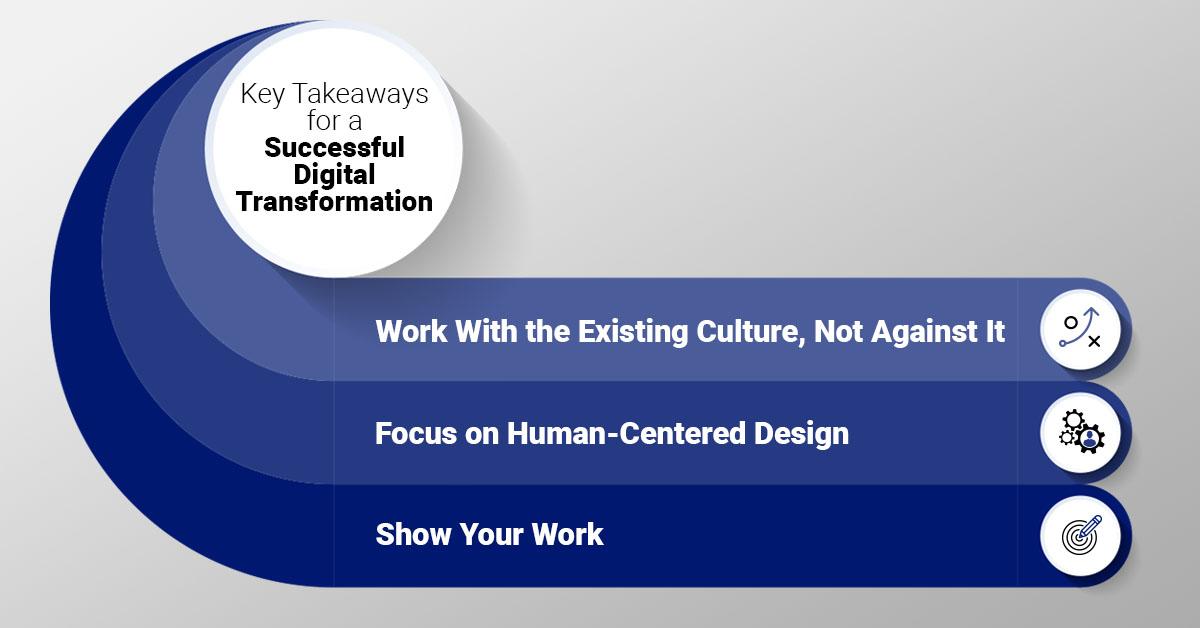
Three Considerations for VA and DHA Digital Transformation
Business & Digital Transformation, Digital Solutions, Performance Optimization, Data & Analytics, Health, Innovation at the Pace of Need™, Innovation in VA Health, Innovation at LMI, Human Centered Design, Digital Health SolutionsThe U.S. Department of Veterans Affairs (VA) and Defense Health Agency (DHA) are digitally transforming their organizations to improve patient outcomes. A rigorous focus on process, design, and support—not just a software solution—will drive innovation and efficiency while meeting the ambitious performance agenda. LMI experts have been strategic partners throughout other large-scale digital transformations and offer insights to help these projects succeed.

Work With the Existing Culture, Not Against It
Large, multifaceted organizations, like the VA and DHA, have existing cultures, hierarchies, and processes. Many of these processes affect patient outcomes. Therefore, change must be carefully considered and executed. Digital transformations often require significant adjustments to systems and expectations. Before beginning a new transformation or expanding on one, project teams must understand an organization’s culture to build a transformation plan that works with that culture, not against it.
“Because large organizations are constantly transforming, there are many dynamics at play,” says Randal Dragon, a principal in business development at LMI. “My work with the Army taught me the importance of getting buy-in from top leadership and then having those folks champion the change with their teams. Culture is embedded; it drives roles and responsibilities, and leaders set the tone.”
John Morris, a principal technical advisor for enterprise resource planning systems analysis at LMI, agrees. “There are often many good reasons why specific roles and processes exist, even if they aren’t aligned with the goals of digital transformation. If outside groups change those processes without understanding the origins and without sponsorship from leaders, it is harder to get projects off the ground,” he says.
Starting with culture also gives leaders and technology partners an opportunity to explain the goals of a digital transformation effort. Outlining how people will save time and resources going forward can overcome resistance to initial cultural challenges if people get a feel for the results early on. Involving frontline users from the onset is a good way to build project momentum and better understand project requirements.
“My work with the Army taught me the importance of getting buy-in from top leadership and then having those folks champion the change with their teams. Culture is embedded; it drives roles and responsibilities, and leaders set the tone.”
— Randal Dragon, Principal, Business Development
Focus on Human-Centered Design
Human-centered design is commonly used in process, product, service, and system design to put human perspectives, emotions, and needs at the center of the design and development process. Using this framework is especially helpful in health-centered organizations that focus on improving patient outcomes. If a project team already understands the culture and systems, this data informs a human-centered design framework for digital transformation.
“With digital transformation projects, you have to gather feedback throughout the process. If you don't have a good plan for that early, you might resort to surveys and less helpful tools,” explains Dragon. “With a human-centered design, the feedback is iterative and continuous, enabling agile course correction.”
Barry Durant, a program manager for enterprise operations for Global Combat Support System-Army—Aviation Logistics and Logistics Data Analysis Center at LMI, adds that this framework answers critical questions about transformation. He notes the importance of project teams focusing on why something is being transformed.
“The goal of a digital transformation is usually to get better visibility into an organization, and you need all kinds of data and feedback for that,” he explains, adding that everyone must be included when considering human-centered design, from frontline workers to—in the case of healthcare—patients. “That means being able to ask, ‘What are we migrating, what are we skipping, what are we just living with, and why?’ People with institutional knowledge are best positioned to answer those questions and provide feedback to a solutions architect or the project team handling the transformation.”
Show Your Work
As projects get underway, the project team must maintain not only momentum but also project support. Because digital transformations are multiyear efforts, their culmination may not be immediately apparent. As a result, projects risk becoming under-resourced over time, increasing the difficulty of reaching the goal. Digital transformation teams can mitigate this risk by creating intermediate prototypes and communicating milestone achievements to the broader organization.
“If you show quick wins or present a prototype for feedback, people feel involved in the process,” Dragon says. “They start to think about transformation in their everyday context, and that supports a project as it gets to the finish line because people will seek or expect that change.”
Meet the Moment
Digital transformation can be daunting. Begin by understanding and working with the organization’s culture rather than against it. Successful digital transformations require organizational buy-in to withstand the years of work they require.
Putting humans at the center of project planning and design is critical to getting and maintaining that support. In a field like healthcare, where patient outcomes are the most important factor, building a deep relationship with frontline stakeholders is key. These individuals can guide project requirements and provide feedback throughout. For healthcare specifically, engaging with the whole organization throughout the transformation will ensure that patient needs remain front of mind and that any impact on patient outcomes is transmitted early. These practices will ultimately lead to project success.

LMI has more than two decades of experience analyzing diverse healthcare data to inform health program and policy improvements. We work at the intersection of science, policy, logistics, and analytics to facilitate innovation in healthcare provision and payment, implement federal healthcare priorities, advance health security, and optimize service delivery and program effectiveness.
For more information, please contact:
- Bettina Kolleda, Vice President, Business Transformation
- Ashley Jung, Vice President, Human Capital Solutions


Randal Dragon
Principal, Business DevelopmentPrior to joining LMI in 2019, Randy Dragon acted in executive leadership and management positions in the United States Army, joint and multinational forces, and the defense industry.


Bettina Kolleda
Vice President, Civilian Agencies SubmarketBettina has over 15 years of experience supporting business and digital transformation programs across various markets, including defense and civilian. For LMI, she stood up and oversees the business transformation sub-service line, home to our strategic planning, product innovation, and change management experts.


Ashley Jung
Vice President, Human Capital SolutionsAshley Jung is the vice president of human capital solutions at LMI, where she directs digital transformation strategies for federal customers. With a diverse background encompassing military service, consulting, and entrepreneurship, she began her notable career at the United States Military Academy, earning significant accolades in academics and athletics.


